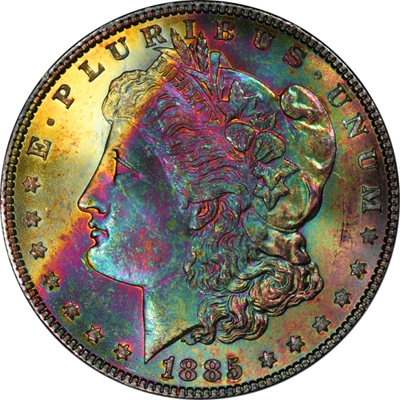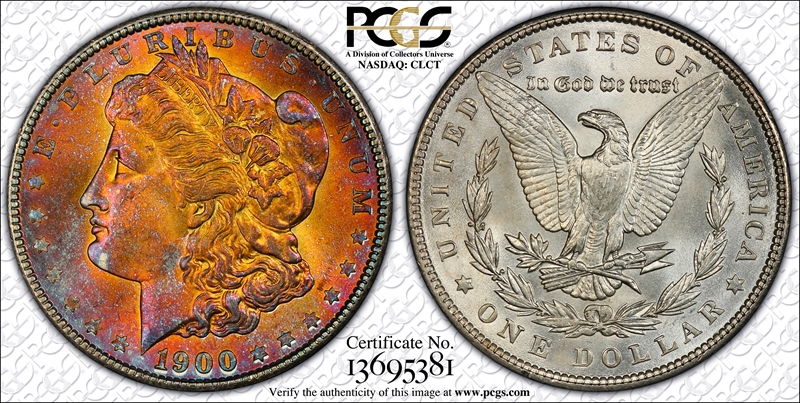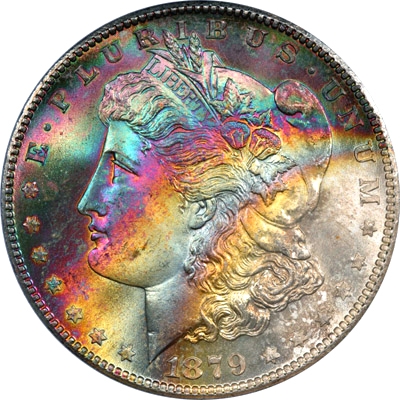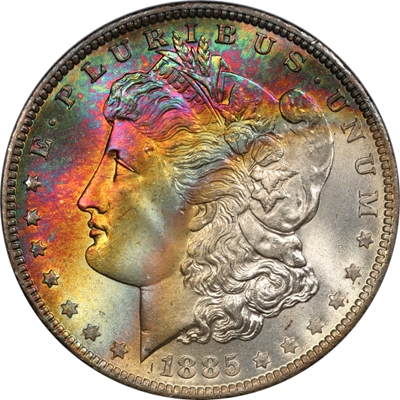Options
The occurrence and appearance of golds and yellows on toned coins
In another thread, STONE asked whether there is any natural reaction that could turn a silver coin yellow or gold in color. The coin he was asking about appears to have been plated, but I decided to address the issue of gold and yellow colors on toned coins.
The first colors in the natural thin film toning progression are various shades of gold. In my classification system, I refer to them as light gold (class A), medium gold (class , and amber (class C) to russet (class D). These are "first cycle" colors. Further along in the progression, we return to some colors that are more *yellow*. In my system, these include lemon yellow (class I), sunset yellow (class J), to orange (class K); these are "second cycle" colors. The point of the class designations is to show you where these colors fall in the progression. There is also a thrid cycle gold (class S) which is much more rare, and has an altogether different appearance.
, and amber (class C) to russet (class D). These are "first cycle" colors. Further along in the progression, we return to some colors that are more *yellow*. In my system, these include lemon yellow (class I), sunset yellow (class J), to orange (class K); these are "second cycle" colors. The point of the class designations is to show you where these colors fall in the progression. There is also a thrid cycle gold (class S) which is much more rare, and has an altogether different appearance.
It is possible to have a coin toned almost entirely in one color class. That essentially means that the toning layer is extremely uniform in thickness. This is much more likely on a small diameter coin; almost all larger colorfully toned coins will tend to exhibit multiple color classes. One way to achieve an extremely uniform coloration is through artificial toning - specifically, by heating in air to a controlled temperature, and allowing the coin to oxidize uniformly. However, it is also possible (although generally quite uncommon) to have uniform colors through natural toning. Usually in the natural toning, there will be some non-uniformities, e.g. in the recessses or at the perimeter. The heat-toned coins are usually too obvious - way too uniform and perfect.
Here are examples of first cycle gold colors, classes A & B (1895-O dollar), and class C (1887-O dollar):


Contrast the above with the more yellow second cycle colors (classes I, J) in these coins (I don't have any where it covers the entire coin, but it is theoretically possible, and much more likely on a smaller diameter coin):


This one ranges from sunset yellow through orange (class K) and beyond:

Here is a coin with a nice amount of the rare third cycle gold, which comes after emerald green in the progression. (This coin does not belong to me.)

Finally, here are some banded rainbow toners that show the first cycle gold/amber (next to the untoned silver area) and second cycle yellows, in the context of a more complete spectrum of toning:


Anyway, I hope this helps to show the different kinds of golds and yellows that are possible with natural (or artificial) toning. The natural toning will always show some gradations in color, even if subtle.
Best,
Sunnywood
The first colors in the natural thin film toning progression are various shades of gold. In my classification system, I refer to them as light gold (class A), medium gold (class
It is possible to have a coin toned almost entirely in one color class. That essentially means that the toning layer is extremely uniform in thickness. This is much more likely on a small diameter coin; almost all larger colorfully toned coins will tend to exhibit multiple color classes. One way to achieve an extremely uniform coloration is through artificial toning - specifically, by heating in air to a controlled temperature, and allowing the coin to oxidize uniformly. However, it is also possible (although generally quite uncommon) to have uniform colors through natural toning. Usually in the natural toning, there will be some non-uniformities, e.g. in the recessses or at the perimeter. The heat-toned coins are usually too obvious - way too uniform and perfect.
Here are examples of first cycle gold colors, classes A & B (1895-O dollar), and class C (1887-O dollar):


Contrast the above with the more yellow second cycle colors (classes I, J) in these coins (I don't have any where it covers the entire coin, but it is theoretically possible, and much more likely on a smaller diameter coin):


This one ranges from sunset yellow through orange (class K) and beyond:

Here is a coin with a nice amount of the rare third cycle gold, which comes after emerald green in the progression. (This coin does not belong to me.)

Finally, here are some banded rainbow toners that show the first cycle gold/amber (next to the untoned silver area) and second cycle yellows, in the context of a more complete spectrum of toning:


Anyway, I hope this helps to show the different kinds of golds and yellows that are possible with natural (or artificial) toning. The natural toning will always show some gradations in color, even if subtle.
Best,
Sunnywood
0

Comments
The third cycle yellow picture is not showing on my monitor. Perhaps it's not linked?
"Bongo hurtles along the rain soaked highway of life on underinflated bald retread tires."
~Wayne
classic dip stain toning. Just not fully
rinsed after it was dipped. But still attractive,
probably took many years to get that way.
The others are probably AT, I have learned
to steer very clear of those one sided toners,
the tone boys are getting particularly good
at the one sided AT.
Regards, Steve K.
As for the other coins, they are not even remotely AT. A better familiarity with the history of Morgan dollars and their unique rainbow bag toning would lead you to a different and more accurate conclusion.
However, I do very much agree that it is wise to avoid collecting areas that you are less familiar with.
Best,
Sunnywood
Sunnywood's Rainbow-Toned Morgans (Retired)
Sunnywood's Barber Quarters (Retired)
Ray
Thanks once more for your informative thread. And for being nice to the responder who thinks these beautiful coins might be AT. I don't know if I could do so, if a non-collector of my favorite series said that my best bust half seemed overgraded, less than well-struck, and should be dipped to get rid of the tarnish and dirt.
This forum can be a great place to learn, and enjoy the wonders of many series that we do not collect.
Hopefully, more of the newer members can learn from the pro's, like you, who know their s...t.
Sorry to say I'm a bit suspicious when someone here since 2002 with 190 posts comes out making such a strong AT statement. Thanks, Sunnywood, for posting so many informative threads on the aspects of toning you've researched.
Due to the fact that my coin had just a limited amount of luster beneath the "yellow filament" on each side I grew extremely skeptical
whether it could have occured naturally with such pronounced and bold yellow color.
Your coins clearly dispell the idea that my coin was the 100% result of NT, and was/is most likely a plating job that is wearing off.
I thoroughly enjoyed reading this informative thread and hope you continue with it
I'd be a buyer.
Had a recent experience with a one sider,
guess I let it color my opinion.
Regards, Steve K.
nicknut, no problem. Among Morgans in particular, there are many legitimate one-sided toners because of the way they were stored in bags, and the way they reacted to those storage conditions. Also there are many one-sided end-roll toners from paper-wrapped bank rolls.
At their best, these forums not only allow us to exchange facts, ideas and opinions, but also to learn something. I know I often learn from the better posts here ... and if I can return the favor by helping someone else learn, that's great.
Best,
Sunnywood
Sunnywood's Rainbow-Toned Morgans (Retired)
Sunnywood's Barber Quarters (Retired)
Sunnywood's Rainbow-Toned Morgans (Retired)
Sunnywood's Barber Quarters (Retired)
Positive BST Transactions (buyers and sellers): wondercoin, blu62vette, BAJJERFAN, privatecoin, blu62vette, AlanLastufka, privatecoin
#1 1951 Bowman Los Angeles Rams Team Set
#2 1980 Topps Los Angeles Rams Team Set
#8 (and climbing) 1972 Topps Los Angeles Rams Team Set
The point of this thread was to demonstrate that yellows and gold do occur throughout the natural toning color progression that results from the thin film interference effect. There are 1st cycle gold and amber colors, 2nd cycle yellow and orange colors, and the unique 3rd cycle gold color which is more rare, and beautiful. This can happen on nickels just as on silver coins. Wild colors are seen more often on Morgans only because of their unique specific history.
Sunnywood
Sunnywood's Rainbow-Toned Morgans (Retired)
Sunnywood's Barber Quarters (Retired)